Horology (“the study of time”, related to Latin horologium from Greek ὡρολόγιον, “instrument for telling the hour”, from ὥρα hṓra “hour; time” and -o- interfix and suffix -logy) is the study of the measurement of time. Clocks, watches, clockwork, sundials, hourglasses, clepsydras, timers, time recorders, marine chronometers, and atomic clocks are all examples of instruments used to measure time. In current usage, horology refers mainly to the study of mechanical time-keeping devices, while chronometry more broadly includes electronic devices that have largely supplanted mechanical clocks for the best accuracy and precision in time-keeping.
People interested in horology are called horologists. That term is used both by people who deal professionally with timekeeping apparatus (watchmakers, clockmakers), as well as aficionados and scholars of horology. Horology and horologists have numerous organizations, both professional associations and more scholarly societies. The largest horological membership organisation globally is the NAWCC, the National Association of Watch and Clock Collectors, which is USA based, but also has local chapters elsewhere.
Museums and libraries
Universal Clock at the Clock Museum in Zacatlán, Puebla, Mexico
There are many horology museums and several specialized libraries devoted to the subject. One example is the Royal Greenwich Observatory, which is also the source of the Prime Meridian (longitude 0° 0′ 0″), and the home of the first marine timekeepers accurate enough to determine longitude (made by John Harrison). Other horological museums in the London area include the Clockmakers’ Museum, which re-opened at the Science Museum in October 2015, the horological collections at the British Museum, the Science Museum (London), and the Wallace Collection.
In Upton, UK, at the headquarters of the British Horological Institute, there is the Museum of Timekeeping.
One of the more comprehensive museums dedicated to horology is the Musée international d’horlogerie in La Chaux-de-Fonds (Switzerland). The Musée d’Horlogerie du Locle is smaller but located nearby. One of the better horological museums in Germany is the Deutsches Uhrenmuseum in Furtwangen im Schwarzwald, in the Black Forest. The two leading specialised horological museums in North America are the National Watch and Clock Museum in Columbia, Pennsylvania and the American Clock and Watch Museum in Bristol, Connecticut.
The eastern French city of Besançon has the Musée du Temps (Museum of Time) in the historic Palais Grenvelle.
An example of a museum devoted to one particular type of clock is the Cuckooland Museum in the UK, which hosts the world’s largest collection of antique cuckoo clocks.
One of the most comprehensive horological libraries open to the public is the National Watch and Clock Library in Columbia, Pennsylvania. Other good horological libraries providing public access are at the Musée international d’horlogerie in Switzerland, at the Deutsches Uhrenmuseum in Germany, and at the Guildhall Library in London.
Another museum dedicated to clocks is the Willard House and Clock Museum in Grafton, Massachusetts.
In Serpa and Évora, in Portugal, you can visit Museu do Relógio
Organizations
Notable scholarly horological organizations include:
- American Watchmakers-Clockmakers Institute – AWCI (United States of America)
- Antiquarian Horological Society – AHS (United Kingdom)
- British Horological Institute – BHI (United Kingdom)
- Chronometrophilia (Switzerland)
- Deutsche Gesellschaft für Chronometrie – DGC (Germany)
- Horological Society of New York – HSNY (United States of America)
- National Association of Watch and Clock Collectors – NAWCC (United States of America)
- UK Horology – UK Clock & Watch Company based in bristol
World exhibitions
- BaselWorld
- Geneva Time Exhibition
- Salon International de la Haute Horlogerie (SIHH)
Glossary
| Term | Explanation |
|---|---|
| Chablon | French term for a watch movement (not including the dial and hands), that is not completely assembled. |
| Ébauche | French term (commonly used in English-speaking countries) for a movement blank, i.e., an incomplete watch movement sold as a set of loose parts—comprising the main plate, bridges, train, winding and setting mechanism, and regulator. The timing system, escapement, and mainspring, however, are not parts of the ébauche. |
| Établissage | French term for the method of manufacturing watches or movements by assembling their various components. It generally includes the following operations: receipt, inspection and stocking of the “ébauche”, the regulating elements and the other parts of the movement and of the make-up; assembling; springing and timing; fitting the dial and hands; casing; final inspection before packing and dispatching. |
| Établisseur | French term for a watch factory that assembles watches from components it buys from other suppliers. |
| Factory, works | In the Swiss watch industry, the term manufacture is used of a factory that manufacturers watches almost completely, as distinct from an atelier de terminage, which only assembles, times, and fits hands and casing. |
| Manufacture d’horlogerie | French term for a watch factory that produces components (particularly the “ébauche”) for its products (watches, alarm and desk clocks, etc.). |
| Terminage | French term denoting the process of assembling watch parts for the account of a producer. |
| Termineur | French term for an independent watchmaker (or workshop) engaged in assembling watches, either wholly or in part, for the account of an “établisseur” or a “manufacture”, who supply the necessary loose parts. See “atelier de terminage” above. |

